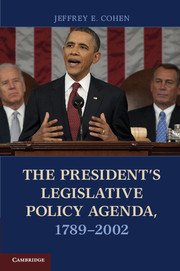Book contents
- Frontmatter
- Contents
- List of Figures
- List of Tables
- Introduction
- Chapter 1 The President's Legislative Policy Agenda
- Chapter 2 Studying Agenda Building
- Chapter 3 A Theory of Presidential Agenda Building and the Congressional Response
- Chapter 4 The Size of the President's Agenda, 1789–2002
- Chapter 5 The Substantive Content of Presidential Agendas
- Chapter 6 Divided Government and Presidential Policy Moderation
- Chapter 7 From the White House to Capitol Hill
- Chapter 8 Conclusion
- Bibliography
- Index
Chapter 6 - Divided Government and Presidential Policy Moderation
Published online by Cambridge University Press: 05 November 2012
- Frontmatter
- Contents
- List of Figures
- List of Tables
- Introduction
- Chapter 1 The President's Legislative Policy Agenda
- Chapter 2 Studying Agenda Building
- Chapter 3 A Theory of Presidential Agenda Building and the Congressional Response
- Chapter 4 The Size of the President's Agenda, 1789–2002
- Chapter 5 The Substantive Content of Presidential Agendas
- Chapter 6 Divided Government and Presidential Policy Moderation
- Chapter 7 From the White House to Capitol Hill
- Chapter 8 Conclusion
- Bibliography
- Index
Summary
The November 2010 midterms handed congressional Democrats and President Barack Obama a sound electoral defeat. House Republicans gained 63 seats, enough to assume control of the next Congress, whereas the Democratic majority in the Senate fell from 57 to 53. Somewhat surprisingly, the lame duck interregnum from the election to the convening of the new Congress in January 2011 produced a flurry of major legislation, much of it promoted and supported by the president.
Why was the 111th Congress so legislatively productive after the election results came in, especially with a new partisan majority that would assume control of the House in the next Congress? One possibility is that the outgoing Democrats in Congress viewed November and December 2010 as their last chance to forge legislation to their liking before the 112th Congress took session. Republicans in the 111th Senate had enough votes to stymie legislative progress to the end of the session by filibustering, however, and presidential veto threats could not force recalcitrant Republicans to produce legislation given the short time span until the new Congress convened.
- Type
- Chapter
- Information
- The President's Legislative Policy Agenda, 1789–2002 , pp. 188 - 207Publisher: Cambridge University PressPrint publication year: 2012

